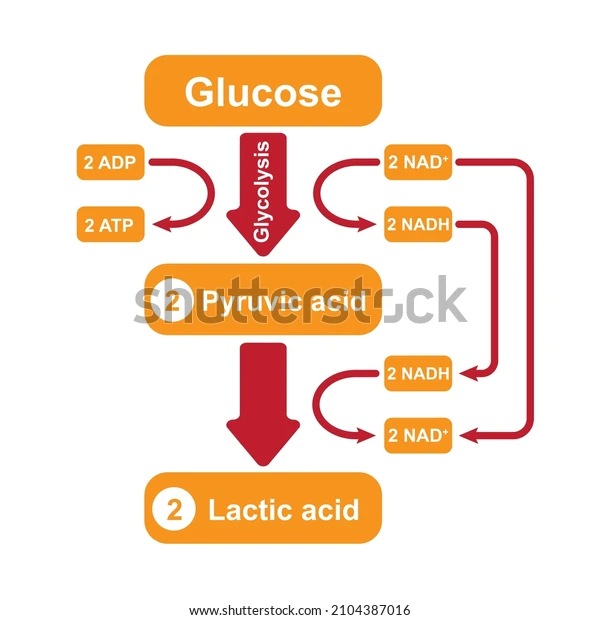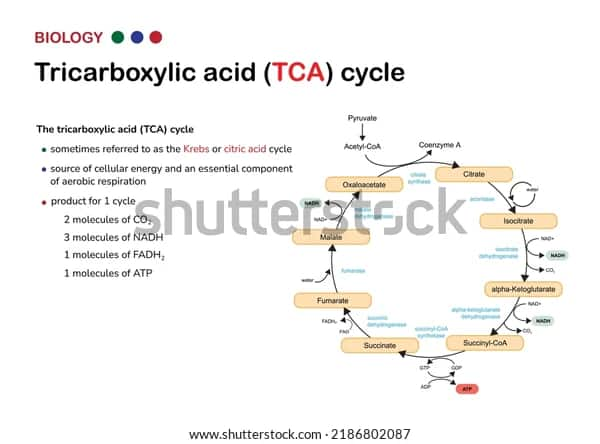How Many ATP are Produced in Glycolysis and The TCA Cycle
In Glycolysis
ATP produced: 2 ATP
During glycolysis, one molecule of glucose (6 carbon) is converted into two molecules of pyruvate (3 carbon), producing 2 ATP molecules through substrate-level phosphorylation.
InTCA Cycle (Krebs Cycle or Citric Acid Cycle)
ATP produced: 2 ATP
Explanation: The TCA cycle is a series of chemical reactions that generates energy through the oxidation of acetyl-CoA derived from pyruvate. During the TCA cycle, each molecule of acetyl-CoA generates 1 ATP molecule through substrate-level phosphorylation, and an additional ATP molecule is produced by oxidative phosphorylation (through the electron transport chain) for a total of 2 ATP per acetyl-CoA.
What is Glycolysis?

Glycolysis is the metabolic pathway that serves as the first step in the breakdown of glucose to produce energy. It takes place in the cytoplasm of the cell and does not require oxygen. The process can be summarized as follows:
Glucose (6-carbon) is converted into two molecules of glyceraldehyde-3-phosphate (3-carbon) through the action of enzymes.
Each glyceraldehyde-3-phosphate molecule is then converted into 1,3-bisphosphoglycerate through a series of reactions that also generate a molecule of ATP (substrate-level phosphorylation).
The 1,3-bisphosphoglycerate molecules are then converted into 3-phosphoglycerate, which is further converted into 2-phosphoglycerate.
The 2-phosphoglycerate molecules are then converted into phosphoenolpyruvate (PEP) through another substrate-level phosphorylation reaction, generating another ATP molecule.
The PEP molecules are then converted into pyruvate (3-carbon), which can enter the citric acid cycle (TCA cycle) to produce more energy.
Overall, glycolysis produces a net gain of 2 ATP molecules per molecule of glucose. However, glycolysis is not very efficient in terms of energy production compared to the citric acid cycle and oxidative phosphorylation, which occur in the presence of oxygen.
TCA Cycle

The TCA cycle, also known as the Krebs cycle or the citric acid cycle, is a series of chemical reactions that occur in the mitochondria of eukaryotic cells. It plays a crucial role in cellular respiration by generating energy through the oxidation of acetyl-CoA derived from the breakdown of carbohydrates, fats, and proteins.
The TCA cycle can be summarized as follows:
Acetyl-CoA (2-carbon) enters the TCA cycle and combines with oxaloacetate (4-carbon) to form citrate (6-carbon).
Citrate is then converted into isocitrate through the action of the enzyme aconitase.
Isocitrate is then converted into alpha-ketoglutarate through the action of the enzyme isocitrate dehydrogenase.
Alpha-ketoglutarate is then converted into succinyl-CoA through the action of the enzyme alpha-ketoglutarate dehydrogenase. This reaction also generates a molecule of NADH, which will be used in the electron transport chain to generate ATP.
Succinyl-CoA is then converted into succinate through the action of the enzyme succinyl-CoA synthetase.
Succinate is then converted into fumarate through the action of the enzyme succinate dehydrogenase. This reaction also generates another molecule of NADH.
Fumarate is then converted into malate through the action of the enzyme fumarase.
Malate is then converted back into oxaloacetate, completing the TCA cycle.
The TCA cycle generates energy through substrate-level phosphorylation (the transfer of a phosphate group from a high-energy molecule to ADP to form ATP) and through oxidative phosphorylation (the production of ATP through the electron transport chain in the presence of oxygen). The TCA cycle produces a net gain of 2 ATP molecules per molecule of acetyl-CoA.
In addition to generating energy, the TCA cycle also plays a role in the regulation of cellular metabolism and the synthesis of important biomolecules, such as amino acids and fatty acids.
Conclusion
During glycolysis, one molecule of glucose (6 carbon) is converted into two molecules of pyruvate (3 carbon), producing 2 ATP molecules through substrate-level phosphorylation. This process takes place in the cytoplasm of the cell and does not require oxygen.
The TCA cycle is a series of chemical reactions that occur in the mitochondria of eukaryotic cells and generate energy through the oxidation of acetyl-CoA derived from the breakdown of carbohydrates, fats, and proteins.
Each molecule of acetyl-CoA generates 1 ATP molecule through substrate-level phosphorylation during the TCA cycle, and an additional ATP molecule is produced by oxidative phosphorylation (through the electron transport chain) for a total of 2 ATP per acetyl-CoA. The TCA cycle is a crucial component of cellular respiration and plays a major role in the generation of energy in the cell.
Applications for Admissions are open.
As per latest syllabus. Physics formulas, equations, & laws of class 11 & 12th chapters
JEE Main Important Chemistry formulas
Get nowAs per latest syllabus. Chemistry formulas, equations, & laws of class 11 & 12th chapters
JEE Main high scoring chapters and topics
Get nowAs per latest 2024 syllabus. Study 40% syllabus and score upto 100% marks in JEE
JEE Main Important Mathematics Formulas
Get nowAs per latest syllabus. Maths formulas, equations, & theorems of class 11 & 12th chapters